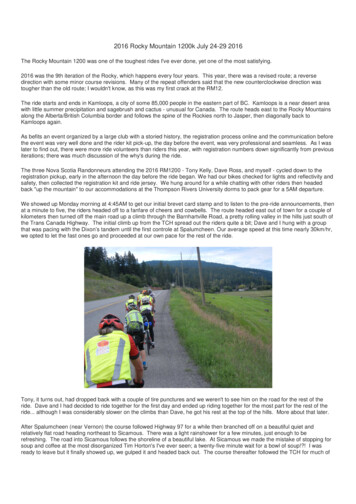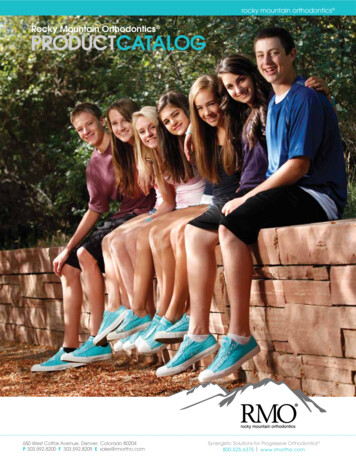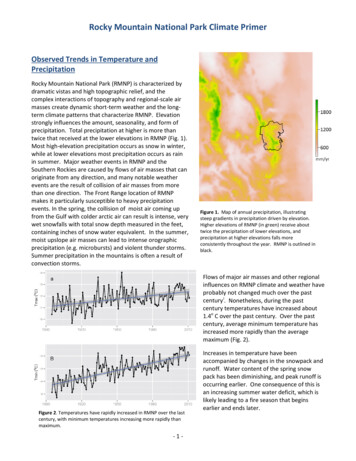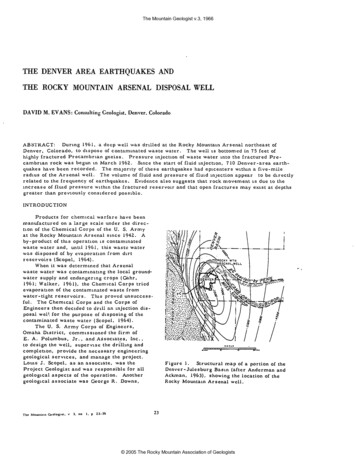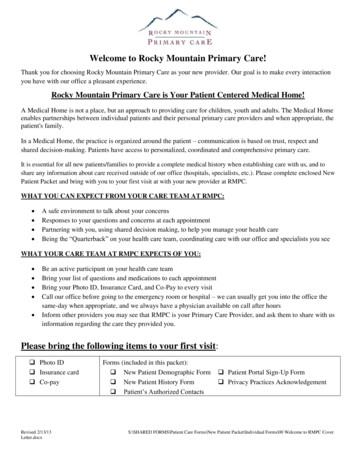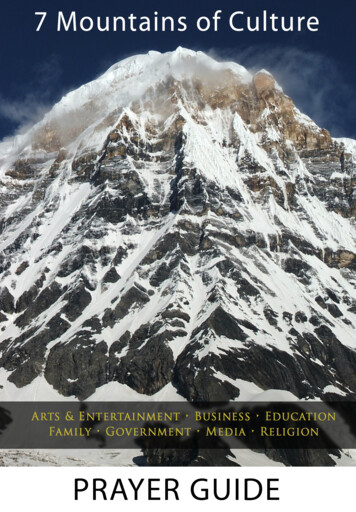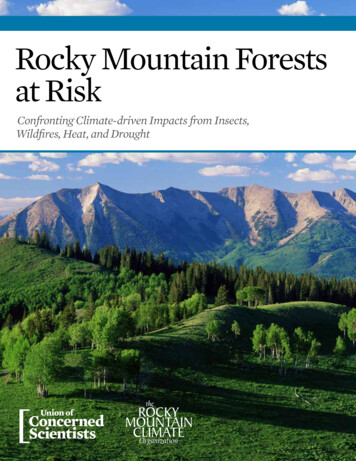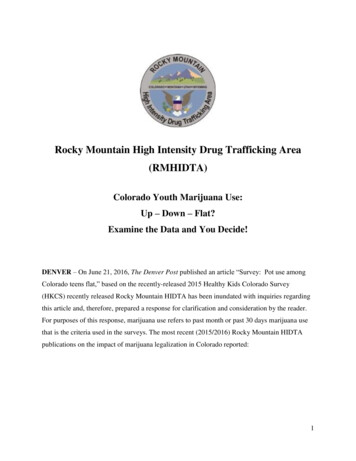
Transcription
Rocky Mountain High Intensity Drug Trafficking Area(RMHIDTA)Colorado Youth Marijuana Use:Up – Down – Flat?Examine the Data and You Decide!DENVER – On June 21, 2016, The Denver Post published an article “Survey: Pot use amongColorado teens flat,” based on the recently-released 2015 Healthy Kids Colorado Survey(HKCS) recently released Rocky Mountain HIDTA has been inundated with inquiries regardingthis article and, therefore, prepared a response for clarification and consideration by the reader.For purposes of this response, marijuana use refers to past month or past 30 days marijuana usethat is the criteria used in the surveys. The most recent (2015/2016) Rocky Mountain HIDTApublications on the impact of marijuana legalization in Colorado reported:1
Federal National Survey According to the National Survey on Drug Use and Health (NSDUH), an annual surveyby the federal Substance Abuse and Mental Health Services Administration (SAMHSA):o When recreational marijuana was legalized in Colorado, youth ages 12 – 17 pastmonth marijuana use increased 20 percent comparing the two-year average justprior to legalization (2011/2012) to the two-year average when legalized(2013/2014).o The 2013/2014 survey results show Colorado youth ranked No. 1 in the nation forpast month marijuana use, up from No. 4 in 2011/2012.o Colorado youth past month marijuana use for 2013/2014 was 74 percent higherthan the national average (12.56 percent vs. 7.22 percent).What do School Resource Officers Say? In a 2015 survey of 95 school resource officers, 90 percent responded that, sincemarijuana legalization, they have seen an increase in marijuana-related incidents in theirschools. In the same survey, when asked where the students are getting their marijuana, 18 percentsaid from the black market and 81 percent cited friends who get it legally, parents, ormarijuana businesses.What do School Counselors Say? In a similar survey of 188 school counselors, 69 percent responded that, since marijuanalegalization, they have seen an increase in marijuana-related incidents in their school. In the same survey, when asked where the students are getting their marijuana, 18 percentsaid the black market while 82 percent cited friends who get it legally, family members,or marijuana businesses.2
State of Colorado SurveyColorado recently released the results of their Healthy Kids Colorado Survey (HKCS) asreported in the Tuesday, June 21, 2016 issue of The Denver Post with the article titled, “Survey:Pot use among Colo. teens flat.” The article does point out that the 2013 HKCS data shows 19.7percent of teens had used marijuana in the past month compared to 21.2 percent in 2015.Although this is a 7.6 percent increase, the article states the increase is “not statisticallysignificant.” The article states that, in 2009, the rate was 24.8 percent but failed to explain that the2013 and 2015 surveys were much different sampling sizes and the survey methodchanged, thus impacting any comparisons. The article cites the Centers for Disease Control's Youth Risk Behavior Survey (YRBS)to indicate that “marijuana use among teens nationwide also remained flat ” They failedto mention that Oregon and Washington, states with legalized marijuana, and Minnesotadid not participate in the 2015 YRBS. There were also ten states, including Colorado,with unweighted results because their state survey participation rate did not meet the 60percent participation standard set by YRBS.On June 22, 2016, The Denver Post Editorial Board released an editorial titled, “Colorado’s goodnews on teen pot use,” based on the 2015 Healthy Kids Colorado Survey. There are numerousimportant points related to the survey not addressed in the article and editorial:Bad News (see Page 7) Marijuana use among Colorado high school junior and senior students increased 19percent and 14 percent respectively from 2013 to 2015. Only 48 percent of high school students surveyed see marijuana as risky compared to 54percent of those surveyed two years earlier.3
One out of 3 Denver high school juniors and seniors surveyed are marijuana users (a 20percent increase from 2013 to 2015). There was nearly a 50 percent increase in the Boulder/Broomfield region high schooljunior and senior marijuana users. Region 12, consisting of Colorado mountain resort communities to include Grand (GrandLake), Summit (Breckenridge and Keystone), Eagle (Vail and Beaver Creek), Pitkin(Aspen) and Garfield (Glenwood Springs) Counties, saw a 90 percent increase inmarijuana users among their high school seniors and a 54.7 percent increase amongsophomores. Region 11, consisting of Moffat, Rio Blanco, Jackson and Routt (Steamboat Springs)Counties saw increases of 22.2 percent for freshmen, 72.0 percent for sophomores, 18.8percent for juniors and 57.3 percent for seniors. Ten out of the 17 regions, with sufficient participation to be counted, saw an overallincrease in marijuana use.Yes, There is Good News (See Page 7) Region 10, which includes Montrose and Gunnison, and four neighboring counties, had amajor decrease in marijuana users in all four high school grades. This decrease was 51.8percent among freshmen to 24.7 percent among seniors. Region 17, which includes Clear Creek, Park and Teller Counties, saw an overall 17.1percent decrease including a 53.7 percent drop in freshmen marijuana users and a 34.3percent drop in senior users. However, the survey does show an increase in sophomoreusers (12.7 percent) and junior users (7.6 percent). Seven out of 17 regions, with sufficient participation to be counted, saw an overalldecrease in marijuana users.4
The question should be raised as to what message is getting through to students in theregions experiencing overall decreases in marijuana use but missing in those regionsexperiencing increases in use.Other Potentially Pertinent Information Jefferson County (the 2nd largest school district), Douglas County (the 3rd largest schooldistrict), El Paso County (Colorado Springs, 2nd largest metro area), and Weld Countyresults were listed as N/A which means data not available due to low participation in theregion. NOTE: This is a similar reason why HKCS results were considered unweightedby the national YRBS survey. In 2015 the HKCS survey had a response rate of 46 percent, which is well below the 60percent rate required by YRBS. Even though HKCS samples a large number of students,their participation rate is below the industry standard for weighted data.Bottom Line Is the Healthy Kids Colorado Survey “good news” and is Colorado teen marijuana use“flat?” The reader can examine the facts and data to make an informed decision. What isclear is that there is no overall pattern in the HKCS data; thus it is best to refrain fromjumping to conclusions on such an important issue. The HKCS results are highly variablebetween class years and regions from major increases to major decreases.Examples of variances include:o There was a 57.5 percent increase in use among one region’s freshmen while a53.4 percent decrease in another.o In one region there was a 72.0 percent increase in high school sophomore use but,in another, a 38.9 percent decrease.o One region for juniors shows a 49.8 percent increase and another, a 33.1 percentdecrease.5
o In one region, high school seniors had a 90.0 percent increase and in another a34.3 percent decrease.The key is to determine what factors contribute to these major variances across the state and to,therefore, learn what effective tools were used in those regions that successfully reducedmarijuana use among some Colorado students.###6
Source: Healthy Kids Colorado q Adolescent Health DataRegionTotalBy Region2013Total byRegion2015By 220.0%18.416.8-8.7%10.514.941.9%9th Grade 9th Grade201320159th Grade10th Grade11th Grade12th GradePercent 10th Grade 10th Grade Percent 11th Grade 11th Grade Percent 12th Grade 12th Grade hange1Countieslogan, sedgwick, phillips, yuma,washington, ANA12.9*NANA15.9*NANA18.8*NANA4el NA8.7NANABy GradeNA9.4NANABy GradeNAelbert, lincoln, kit carson, cheyennehuerfano, las animas, baca, otero, bent,prowers, crowley, kiowaNANABy GradeNA5NANABy 7.7%26.929.59.7%10pueblosaguache, mineral, rio grande, alamosa,conejos, costilladelores, san juan, montezuma, la plata,archuletasan miguel, montrose, delta, gunnison,hindsdale, 18.1-32.0%32.024.1-24.7%11moffat, routt, jackson, rio 18.8%22.535.457.3%12garfield, pitkin, eagle, summit, 9.2-2.3%20.138.290.0%13lake, chaffee, fremont, 1.8%26.527.33.0%16boulder, 2.333.449.8%28.542.248.1%17gilpin, clear creek, park, A*NANANA6789N/A:*N/A:Data not available due to low participation in region.Region 21 – Jefferson County did not participate in the 2013 Healthy Kids Colorado SurveyNAPage 7 of 7
The most recent (2015/2016) Rocky Mountain HIDTA publications on the impact of marijuana legalization in Colorado reported: 2 . However, the survey does show an increase in sophomore users (12.7 percent) and junior users (7.6 percent). Seven out of 17 regions, with sufficient participation to be counted, saw an overall
